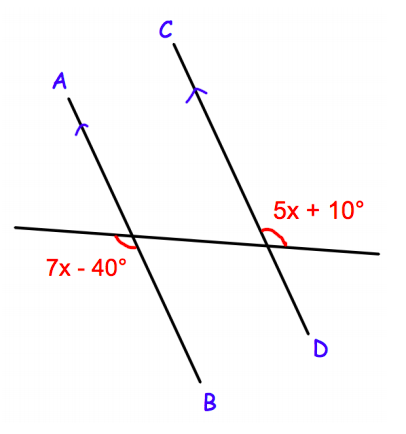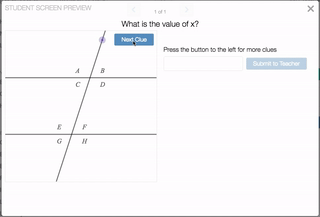First Thoughts
Having already introduced angle relationships in parallel lines (with a transversal), I needed to introduce the concept of using the angle relationships to find missing values. The goals of this activity were to:
While traditional problems could do the trick for this task, they in my opinion fall short in on very big way:
- Force students to identify angle pairs and their relationships
- Use those relationships to find missing values
- Help students realize that they can find the value of an unknown with no more than one angle pair.
While traditional problems could do the trick for this task, they in my opinion fall short in on very big way:
In exercises like the one above students are trained to trust the problem to give them exactly as much information as needed. I wanted students to decide when they had enough information.
The Activity
In order to force students to ask for exactly enough information I decided to create a Desmos activity similar to 20 questions. The activity would be simple:
- Students were given a series of challenges to be completed in order
- Information about each of the angles was given one by one as a "clue"
- Students were only given a limited number of clues to complete the activity.
Where This Lesson Fails
Before you go running off giving this activity to your students know that this activity FAILS in the worst ways. In my defense, I did dream it up at 3 AM and build in in an hour, but the only reason it ever made it on twitter was because of the surprising results from an activity that was not thoroughly vetted before running with students (see "Surprising Results", below).
In the design of the lesson itself:
In the looks of the activity:
In the design of the lesson itself:
- The activity locked students out once they got an answer wrong
- A student could log in repeatedly and answer questions without using clues once they'd seen the correct answer once.
- The CLUES were not thought out. Not only were there staggeringly difficult questions up front but within each challenge clues were not released in an order that would show different levels of understanding.
In the looks of the activity:
- Separate screens were necessary to reveal clues and input answers
- The graph had a generic feel to it. Ideally I want it to be unique to each challenge.
Surprising Results
Despite the design flaws I ran this activity with great success in the classroom. I had to make a few last minute changes like allowing students to run the activity from the beginning when they got a question wrong. In order to incentivize completing the assignment as designed made a "raffle" in each class and gave more entries to groups that took less attempts to complete all 12 challenges. In the end students were so excited to complete the tasks that they were yelling across the room things like "I could do it in two clues"!
In my opinion the surprising success of this activity was not due to the activity itself but to two policies I put into place. First, students were assigned to work in pairs on a single computer and were told to discuss with each other whether or not the clues were sufficient before asking for another clue. Secondly, I had the students record all of their work on the template referenced in the description of the activity and collected the papers at the end of the activity. This allowed me to gain insight into which clues students were using to find missing values.
In my opinion the surprising success of this activity was not due to the activity itself but to two policies I put into place. First, students were assigned to work in pairs on a single computer and were told to discuss with each other whether or not the clues were sufficient before asking for another clue. Secondly, I had the students record all of their work on the template referenced in the description of the activity and collected the papers at the end of the activity. This allowed me to gain insight into which clues students were using to find missing values.
Summary and Next Steps
The success of this activity was a matter of pure chance and created by the lucky combination of a few unplanned modifications. The success I saw in the excitement and retention (class average on the exam was above 85%... higher than I am used to or even comfortable with) was, however, a sign that 20 Questions v2 could have some success.
There are a few changes I want to make:
There are a few changes I want to make:
- Eliminate the "one and done" policy and instead to either a point based system (number correct vs number of clues) or a "three strikes" system.
- Change the format of each screen to make it more intuitive:
- MOST IMPORTANTLY I want to make changes to the clues to reveal information more strategically. My goal is to be able to scroll through student screens and use the clues that were revealed to better understand student thinking. After all, if I can't gain insight to student thinking by accessing the dashboard I am failing to utilize this tool to the best of it's abilities.


 RSS Feed
RSS Feed